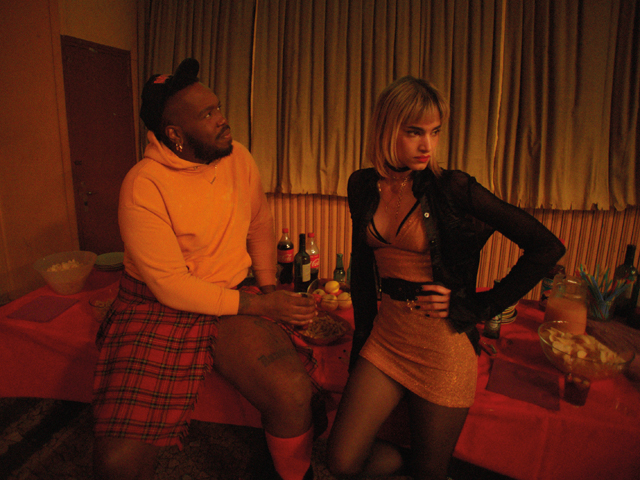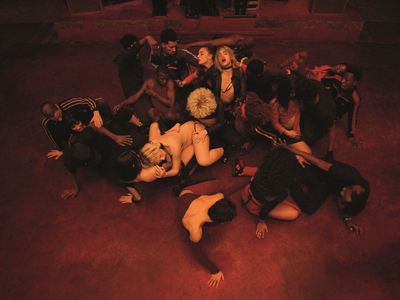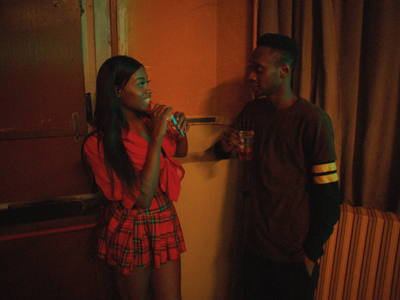Sofia Boutella Climax

Let the Party Begin!
Cast: Sofia Boutella, Romain Guillermic, Souheila Yacoub
Director: Gaspar Noé
Genre: Drama , Horror , Musical
Running Time: 95 minutes
Synopsis: Climax is a 2018 French musical horror film written, co-edited and directed by Gaspar Noé, and starring Sofia Boutella. The plot centres around a troupe of hip-hop dancers experiencing a bad trip after accidentally ingesting psychedelics.
Director's Statement
There are sometimes certain events that are symptomatic of an era. These events explode, spontaneously or otherwise, until they reach the law enforcement agencies; some then become information on a major scale. They take on a new dimension: they are magnified, reduced, misrepresented, digested or not by those who disseminate them and those who receive them. Lives, glorious or shameful alike, end up on paper, then quickly disappear into collective oblivion. Existence is nothing more than a fleeting illusion that each of us takes to the grave. When we read biographies, everything and its contrary is stated. It's the same whenever any affair or a news story is revealed.
And the new communications channels that have spread during the last 20 years have rendered all objectivity even more illusory.
Humans, like animals, are born, live and die leaving no more trace than the smallest daisy in the middle of a field. Joys and pain, achievements and blunders, occupy a virtual perception, a present that doesn't exist outside their memory. In 1996, a million stories hit the headlines, stories that are forgotten today, and tomorrow even more. Some of those born or alive that year are still among us.
But of the great majority of those whose hearts have stopped beating, nothing remains: a name in a cemetery, or in an old newspaper lost in the depths of a cellar. At their most intense, the pleasures of the present allow us to forget this vast emptiness. Joy, ecstasies – whether constructive or destructive – act as an antidote to the void. Love, art, dance, war, sport seem to justify our brief time on earth. And of these distractions, the one that has always made me happiest is dance. So, if I was to make a film, it seemed exciting to make one based on a real news story, with dancers whose talents mesmerized me. With this project, once again, I could represent some of my dreams and nightmares on screen.
1996, it was just last night. Only there were no cell phones or internet. But the best of this morning's music was already there. In France, Daft Punk released their first record, La Haine had just been released in cinemas, and the journal HaraKiri was definitively unable to revive itself. The Massacre of the adepts of the Solar Temple was suppressed by the occult forces of the state. And there were those who dreamed of building a powerful and peaceful Europe while a barbaric war infected its interior.
Wars create movement, populations change, as do beliefs and ways of living… And that which is called God will always be there on the side of the most powerful gun. What was, will be. The comma may move, but the essence of the sentence will always remain the same. I've always been fascinated by situations where chaos and anarchy suddenly spread, whether street brawls, psychotropically enhanced shamanistic sessions, or parties at which the revellers lose control collectively under the influence of excessive alcohol. The same applies to my film shoots. My greatest pleasures lie in having written and prepared nothing in advance, and as much as possible allowing situations to happen in front of me, as in a documentary. And whenever chaos sets in, I'm even happier, knowing that it will generate images of real power, closer to reality than to theatre. For this reason, instead of a real script, I chose as a base the simple telling of this sticky and haunting story. A troupe of dancers gathers in an isolated building to prepare a performance. After their last rehearsal, chaos erupts. Starting from a page-long outline allowed me to capture moments of truth and to convey in images this sequence of events collectively. If you want dancers, actors or non-professionals to express themselves physically and verbally in a chaotic fashion, improvisation is essential. As for the dancing, except for the very first scene which was choreographed, the dancers were free to express themselves in their own language, often very close to the unconscious, revealing their individual interior turmoil. In dance styles like voguing, waacking or krump, the participants display their physical prowess with a jaw-dropping spontaneity. With the very best dancers, this becomes particularly dazzling.
The scenes were shot chronologically to generate both a state of general trust and a spirit of competition that drove the dancers towards ever-more psychotic performances. Contrary to more usual depictions of dance, in which every step is predetermined, I tried to push my protagonists to simulate possessed states like those encountered in ritual trances. Although drugs certainly figure in the story, this time the idea wasn't to depict altered states of perception subjectively through visual effects and sound, but on the contrary, to stick to an external point of view on the characters. Another rule was to film very quickly and in long takes, a choice made possible by shooting on a unique set.
This allowed me to complete every shot in a fortnight during February 2018. We nonetheless rehearsed the first choreographed scene with our dancers. And, to ready them for the other dance sequences, we had them listen to the music already chosen for the film. To talk about dance is to talk about music. To respect the era in which the film is set, the music – whether electrifying or melodious – dates from no later than the mid-90s. And to create a familiar emotional state, we tried to include tracks that would speak to the widest audience.
 From the start the concept was to make a film with the best dancers we could find in France or who could travel there. With the intention of making a film centered on corporal expression, Serge Catoire and I didn't search for actors but scoured krump battles and voguing balls in the Paris region, as well as dance videos on the internet. Very quickly, and instinctively, we understood with which dancers it would be wonderful to form a troupe and film. We convinced the daring Edouard Weil (Rectangle Productions) and Vincent Maraval (Wild Bunch), co-producers of my film LOVE, and the production of this low budget movie was underway. During our very first visit to a voguing ball, as guests of Léa Vlamos, I met Kiddy Smile, huge DJ and musician, who invited me to witness dance battles from the stage. Serge and I hadn't seen such a happening energy on show in Paris since certain violent street demonstrations during our adolescence. We managed to contact the dancers who made us dream and talked to them about a film that already had a story but no predetermined dialogues.
From the start the concept was to make a film with the best dancers we could find in France or who could travel there. With the intention of making a film centered on corporal expression, Serge Catoire and I didn't search for actors but scoured krump battles and voguing balls in the Paris region, as well as dance videos on the internet. Very quickly, and instinctively, we understood with which dancers it would be wonderful to form a troupe and film. We convinced the daring Edouard Weil (Rectangle Productions) and Vincent Maraval (Wild Bunch), co-producers of my film LOVE, and the production of this low budget movie was underway. During our very first visit to a voguing ball, as guests of Léa Vlamos, I met Kiddy Smile, huge DJ and musician, who invited me to witness dance battles from the stage. Serge and I hadn't seen such a happening energy on show in Paris since certain violent street demonstrations during our adolescence. We managed to contact the dancers who made us dream and talked to them about a film that already had a story but no predetermined dialogues. Unexpectedly, the channel ARTE took an interest in the project. Kiddy acted as our 'godfather', contacting - and above all convincing - on our behalf certain of his voguing friends. It seemed obvious that we should offer him the role of DJ Daddy. At the same time, I had the idea of contacting the legendary Sofia Boutella in Los Angeles, whom I had met once, to offer her the driving role of the choreographer. Her dance videos fascinated me as much as she did herself. For some time, she'd committed herself to acting and had appeared in a number of feature films. I knew she would have the strength and the madness necessary to play this extreme and multifaceted role. Before giving me her answer, she recommended the person she considered the best choice to handle the film's choreography, Nina McNeely, and I thank her again for this brilliant idea. The presence of dancers drew others to us, and small groups responded positively to our proposal. We were lucky enough to encounter waackers, krumpers and a group of electro dancers (including Romain Guillermic and Taylor Kastle) who right away sent us videos of themselves simulating trance states. Delight follows delight. In January, I contacted all my most treasured collaborators, who made themselves available (Benoît Debie, Lazare Pedron, Ken Yasumoto, Rodolphe Chabrier, Pascal Mayer, Fred Cambier, Denis Bedlow, Marc Boucrot, Tom Kan and Laurent Lufroy) and to whom were added the encouragements of Thomas Bangalter and two wonderful new associates: production designer Jean Rabasse and first assistant director Claire Corbetta-Doll.
In record time we found a disused school in Vitry and were able to clear the rights to music tracks I'd dreamed of using. Two days before the shoot we met acrobat and actress Souhelia Yacoub and secured a work permit for the astonishing contortionist Strauss Serpent, so he could join us from Cameroon. Nourished by our multiple experiences of uncontrolled crashes, the shoot went ahead in an atmosphere of delight, and the improvisations of the dancers, on the floor or in their extemporised dialogues, dazzled us all. Two months later, we are pleased to present this modest reproduction of the joyful and sad reality.
All my thanks to those who made us, and who are no longer… Let the party begin!
- Gaspar Noe
MORE




